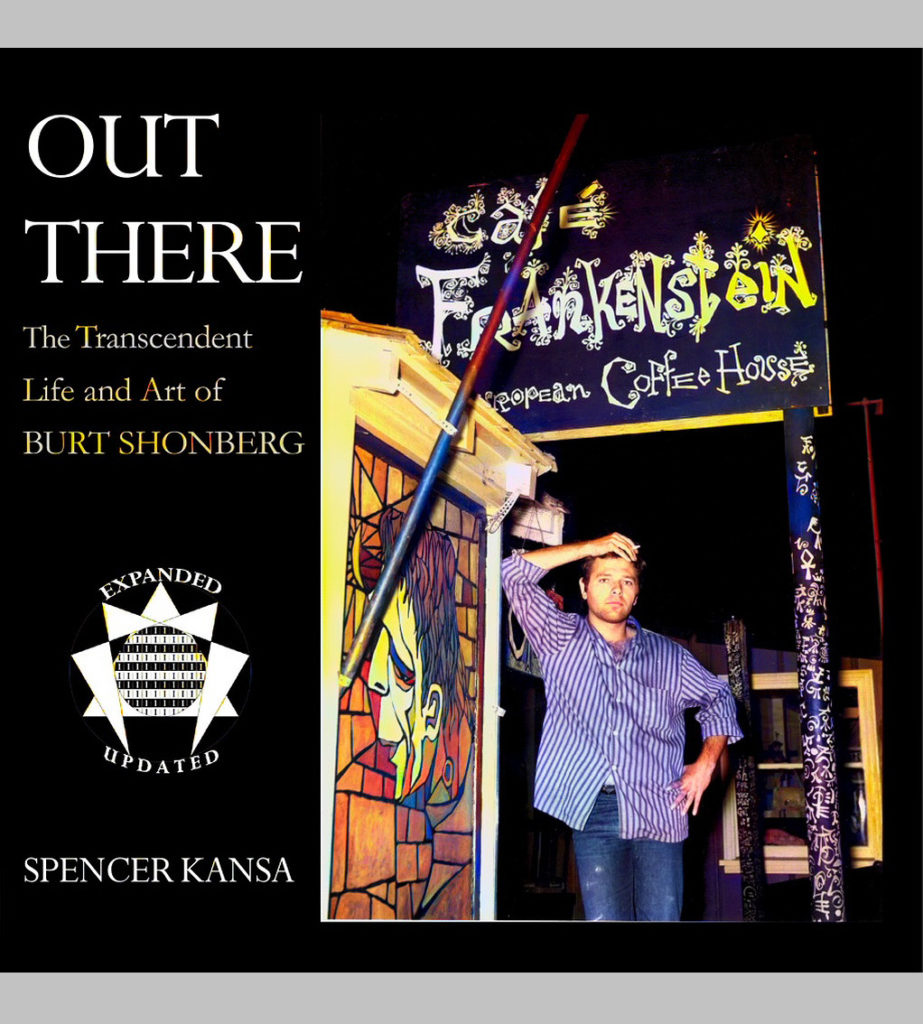
Tag Archives: Occult Art
Pan’s Daughter
Featured
The Magical World of Rosaleen Norton
Revised and Greatly Expanded Edition
Nevill Drury

Pan’s Daughter
The Magical World of Rosaleen Norton
(Revised & Greatly Expanded Edition)
Nevill Drury
Format: Softcover/326 pp/48 illustrations.
ISBN: 978-1-906958-41-1
£22.99/US$32/AUD$36(+$8p&p)
Click Here for Pan’s Daughter / USA
Click Here for Pan’s Daughter / UK
Click Here for Pan’s Daughter / AU
During the 1950s and early 1960s the Sydney-based trance-artist and Pan-worshipper, Rosaleen Norton, was well known in Australia as ‘the Witch of Kings Cross’ and was frequently portrayed in the tabloid press as an evil ‘devil-worshipping’ figure from the red-light district. Norton attracted attention from both the public at large and also the local police for engaging in bizarre pagan sex-rituals with her lover, the poet Gavin Greenlees. Details of these activities would surface from time to time in the local courts when Norton was defending her metaphysical beliefs and seeking to defuse claims that her magical paintings and drawings were obscene. Norton was also associated with the scandal that eventually engulfed the professional career of renowned musical conductor, Sir Eugene Goossens who had arrived in Australia in 1947 and became a member of Norton’s magical coven six years later.
Norton dedicated her magical practice to the Great God Pan and to a lesser extent Hecate, Lilith and Lucifer. She was also intrigued by the visionary potential of Kundalini yoga, out-of-the-body trance exploration and Aleister Crowley’s Thelemic sex magick and combined all of these elements in her ritual activities.
Pan’s Daughter is the only biography of Rosaleen Norton and provides the most detailed and authoritative account of her magical beliefs and practices. First published in Britain by Mandrake in 1993, it is now reissued in a revised and expanded edition.
“Brilliantly researched…outrageous and inspiring”
Fiona Horne, author of Witch – A Personal Journey and Witch – A Magickal Year
“A fascinating study. Drury’s understanding of the occult and spiritual realms makes Norton’s art and life comprehensible” Tom Thompson, Sydney Morning Herald
Dr Nevill Drury (1 October 1947 – 15 October 2013) is best known for his publications on modern Western magic, shamanism and visionary art. For many years he worked in the Australian book industry as an editor and art book publisher and in 2008 he received his Ph.D from the University of Newcastle for a dissertation on the art and magical belifes of Rosaleen Norton.
Surrealism & The Occult
Featured
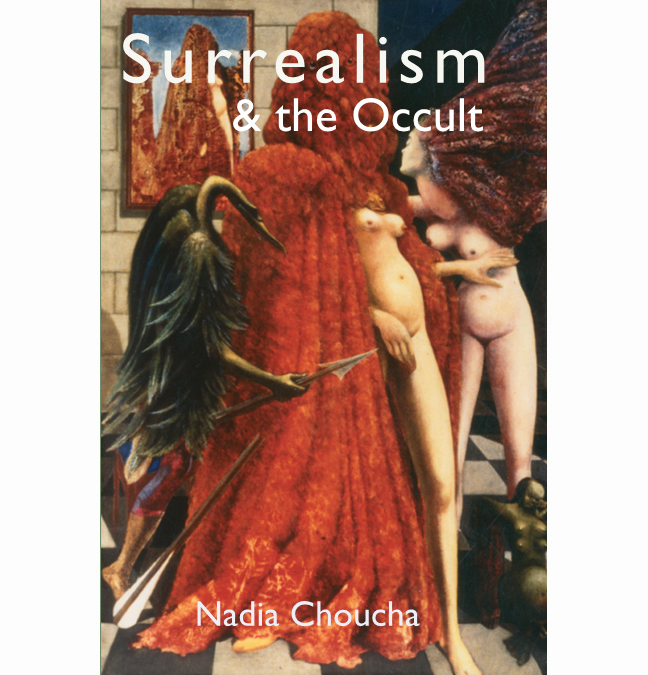
Surrealism & The Occult
Nadia Choucha
Format: Softcover/164 pp.
ISBN: 9781906958749
£15.00
Subjects: Art/Art History/Surrealism/Occult.
Click HERE for the UK edition
Many people associate Surrealism with politics, but it was also permeated by occult ideas, a fact often overlooked by art historians. This occult influence goes beyond general themes to the movement’s very heart.
This occult influence goes beyond general themes to the movement’s very heart. The antinomian stance of Surrealism can be traced directly to the influence of radical nineteenth century magi such as Eliphas Lévi, whose Dogma and Ritual of High Magic was widely read by Surrealism’s ideologues. Amongst these we find its progenitor André Breton.
The book shows how many Surrealists and their predecessors were steeped in magical ideas: Kandinsky, with his involvement with Theosophy, the sorcery of Salvador Dali; the alchemy of Pablo Picasso and the shamanism of Max Ernst and Leonora Carrington.
Surrealism did not establish itself in Britain until the 1930s but a select few felt something in the air. Almost ten years before the Surrealist experiments with automatic drawing, an obscure English artist, Austin Osman Spare had perfected the technique.
Nadia Choucha shows, convincingly, that occult and surrealist philosophies were often interchangeable. Surrealism and the Occult is seminal reading for art historians and occultists alike, while artists will find it a vital guide to the unlocking of the imagination.
Praise for Nadia Choucha’s Surrealism & the Occult
”Highly readable…seminal… fascinating” – Francis X. King
”alive, with the heady mixture of occult and pictorial symbolism treated with laudable lucidity.”- Art Book News
Ithell Colquhoun
Featured
pioneer surrealist artist, occultist, writer and poet
(reprinted)
Eric Ratcliffe
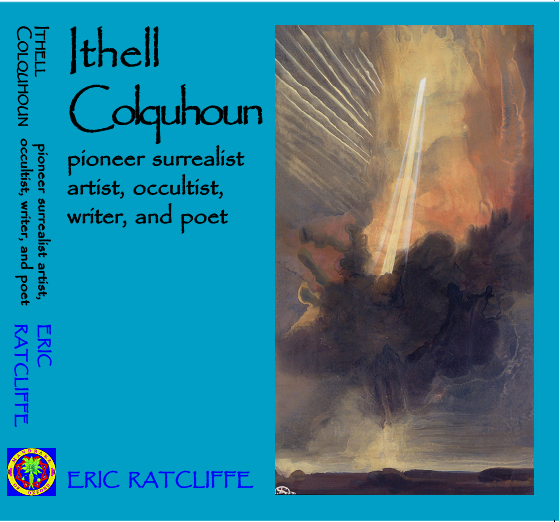
——————————————————————-
Ithell Colquhoun / UK / £30
——————————————————————-
Ithell Colquhoun / USA / US$40
——————————————————————-
Ithell Colquhoun
pioneer surrealist artist, occultist, writer & poet
Eric Ratcliffe
Format: Softcover/312pp/90 illustrations (25 colour).
ISBN: ISBN 978-1869928-98-8
£30/US$40
Subjects: Art/Art History/Surrealism/Occult/Magick/Biography.
–
The skills of Ithell Colquhoun in her main practice, that of artist and pioneer in this country of surrealistic art, have been long recognised. Additionally, other interests – alchemy, Earth-magic, active occultism, poetry, druidism, the pre-Christian pagan calendar, the history and membership of the Golden Dawn – and writing of and involvement in these interests by book publication and in a widely scattered field of correspondence, have created a miscellany of truly gargantuan proportion.
Eric Ratcliffe considered it was time to get together some of these pieces, to add something of what is known of Colquhoun’s early life and family history and to take the opportunity of listing a comprehensive calendar of her work and exhibitions. The result is neither strictly biographical nor a treatise on any one subject, but it is a first gathering of the roots, passions and multi-directions of this artist. It is a patchwork containing many launch-pads for exploration of the magical and mythical atmosphere which this artist existed in and created. Here therefore is a contribution towards solving a jigsaw and a wind-catch of the minor cyclones of lthell’s dedicatory interests, also serving as a record of her accomplishments in the art field.
REVIEWS
‘The subtitle of this book is: ‘Pioneer Surrealist, Artist, Occultist, Writer and Poet’, this multifaceted description captures the essence of who and what Ithell Colquhoun was about. Her connection to Cornwall is through the book The Living Stones, published in 1957, which was an early contribution to discovering the power of the Cornish landscape, prehistory and tradition and folklore. Even today, it continues to inspire people with its love for the ancient land of Cornwall…Ratcliffe’s biography made me want to go back and re-read The Living Stones, and no better thing could be said of a book such as this.’- Cheryl Straffon, Editor in Meyn Mamvro – Ancient stones and sacred sites in Cornwall – www.meynmamvro.co.uk
‘The author gives an excellent account of Colquhoun’s artistic career, explaining why she has been so overlooked (she stuck to her principles against the authoritarian demands of the British surrealist clique and consequently was expelled). Ratcliffe places proper emphasis upon the artist’s magical activities. She was a member of the OTO, Order of the Pyramid and Sphinx, Order of Holy Wisdom, Ancient Celtic Church and the Druid Order.
Despite having had the good fortune to read many of Colquhoun’s magical papers I learnt a great deal from this very well informed work. There is excellent bibliographical information including listings of unpublished typescripts and also as comprehensive as possible listing of her paintings and drawings.’
Ithell Colquhoun by Eric Ratcliffe, Mandrake of Oxford.
Reviewed by Ben Fernee @ Caduceus Books
‘Ithell Colquhoun was a pioneer surrealist artist, poet, writer, pantheist and occultist. Descended from Devonian ancestry, she was of Anglo-Indian birth and received her education in England at the Cheltenham Ladies College and later at the Slade School of Art in London.
After the war she moved to Cornwall where she spent the rest of her life. While at the Slade she became involved in Theosophical circles and then attempted, without success, to join Moina Mathers’ Alpha and Omega Lodge of the Hermetic Order of the Golden Dawn and Dion Fortune’s Fraternity of the Inner Light.
However during the 1950s she belonged to various occult groups including Kenneth Grant’s Typhonian OTO and Nu-Isis Temple, Dr WB Crow’s Order of the Holy Wisdom and Order of the Keltic Cross, Tamara Bourkhoun’s Order of the Pyramid and the Sphinx, as well as the Druid Order, the Cornish and Breton Gorsedd, the Ancient Celtic Church, Co-Freemasonry and the Fellowship of Isis.
This biography is profusely illustrated with many of Colquhoun’s paintings and also includes some of her writings and poetry. It is a fascinating study of a unique multi-talented woman who during her creative life contributed a great deal to both the artistic and occult fields. Recommended.’
Ithell Colquhoun, by Eric Ratcliffe.
Reviewed by Mike Howard in The Cauldron, issue 129, August 2008
Nightshades
Featured
A Tourist Guide to the Nightside
Jan Fries

Nightshades
A Tourist Guide to the Nightside
Jan Fries
Format: Hardback – Cased Matt Laminate A4 216 pp.
ISBN: 978-1-906958-45-9
£24/US$40
Subjects: Aleister Crowley & Thelema/Kenneth Grant/Typhonian Magick/Occult Art.
“Nightshades is the record of one remarkable magician’s exploration of the inverse regions of the Tree of Life. Aleister Crowley’s Liber 231 provides the map and Kenneth Grant’s Nightside of Eden a travelogue. “Liber 231, apparently started life as a text within the Hermetic Order of the Golden Dawn, as an exercise to develop astral and trance abilities or perhaps in other more elaborate rites. The nightside aspect requires some care and alertness in case of accident. The correct attitude is said to be one of self or ego-less witness. Or maybe it’s just one needs the use of an all-embracing rather than a limited kind of identity and self-identification” (mmm)
“The Nightside is always with us. It’s so much older than the Dayside. Before the light began to shine, the night was there. Some assume that we are dealing with a simple polarity. On one hand the radiant world of colours and forms, more or less thinkable, reasonable and meaningful. Like the pretty picture of the Tree of Life it has its scenic cites, its hotels, restaurants, shopping opportunities and highways in between.
On the other hand the chaotic world of uncertain and incomprehensible mysteries. Both of them connected by the voidness that makes them possible. It looks symmetrical. But when you reach the Nightside it doesn’t work like that. The Nightside is not simply a reflection of the dayside with a few confusing and spooky bits thrown in.
The Dayside is a tiny island of experience in a huge ocean, the Nightside, full of currents, island chains and continents of the possible and impossible. All and Nothing are present everywhere. Our island is not the opposite of the world-ocean, it is simply a tiny and comprehensible part of it.” (jf)
Jan Fries Nightshades comprises 72 intense drawings prefaced by an explanatory essay detailing the background and genesis of this ultimate magical adventure.
The Octavo
A Sorcerer-Scientist’s Grimoire
Peter J. Carroll
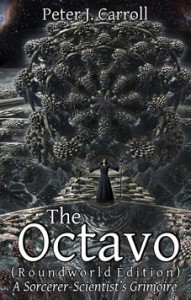
The Octavo
A Sorcerer-Scientist’s Grimoire
Peter J. Carroll
Format: Softcover
ISBN: 9781906958176
£15.00 / US$24.00
Subjects: Chaos Magick
Click HERE for The Octavo / USA
Click HERE for The Octavo / UK
Click here for Kindle UK Edition
Click here for Kindle USA Edition
Every universe potentially has its own Supreme Grimoire containing the spells which define its reality and the magic which you can perform within that reality. In this Octavo we have assembled scattered secrets for a Supreme Grimoire for Roundworld, the universe in which you’re standing.
To this end we have taken some inspiration from Pratchett’s Discworld, and a lot from Theoretical Physics and Practical Chaos Magic.
The most original, and probably the most important, writer on Magick since Aleister Crowley.”
– Robert Anton Wilson. Author of the Cosmic Trigger trilogy.
Review of The Octavo by Dave Lee
This is the second book Pete Carroll has brought out in the last two years, after a number of years’ silence. In 2008, there was ‘The Apophenion’, which was something of a departure towards an overall philosophical position, which we might call chaoism, as distinct from chaos magic. Now he presents us with a new synthesis that aims at a much closer marriage of scientific theory and magic than he, or, to my knowledge, anyone else, has attempted.
The first thing you’ll notice about this book (other than the excellent illustrations) is the subtitle. The reference will be lost on non-Pratchett experts like me; I’ve enjoyed a few of Pratchett’s books and found others a bit twee for my taste. (I have to admit, though, that he shows superb understanding of the thermodynamics of godhood in ‘Small Gods’, and a brilliant vision of the Other in ‘Lords and Ladies.’) Apparently, there’s an Octavo of Discworld spells, and it seems this volume is using the conceit that it’s the Roundworld equivalent in order to show how physics and magic can be combined in two very different universes.
The second thing you’ll notice is the physics. Publishers say that every equation in a book halves the readership, and there are a lot of them in The Octavo*. More, in fact, than in Liber Kaos, but they – at least the ones in the first few chapters – are of a very different kind.
The ‘Equations of Magic’ in Liber Kaos have always been problematic: they dealt in quantities which are not measurable, and probably never will be, like ‘degree of gnosis’ and ‘magical link’. So, they are not really equations, but things that look like equations; what they amount to, at best, is a mental checklist, a summary of what we know about magic so far. With a shorthand like that, all that matters is that it’s easily memorable, and the physico-mathematical symbolism does not help at all.
The equations in Octavo are very different. They are much more ambitious, genuinely cosmogonic in nature, and I suspect they have some very important things to say – to those who understand them rather more deeply than I do. I did get lost for much of chapters 2 and 3 (I only have maths to just short of A-level), but surfaced again at the start of Ch 4, where he compares Discworld and Roundworld physics, and comes out with some pretty profound stuff.
One of the things that’s particularly interesting about Carroll’s science is the way he attributes real physical – or aetheric / shadow-physical – reality to quantities that appear in the fundamental equations of physics. In Liber Kaos for instance the wavefunction in the Schroedinger equation is a measure of a real quantity in shadow-time, rather than a mere mathematical convenience, to be discarded as soon as possible in the course of calculations. No, Carroll finds a home for these misty, despised quantities, integrating them into a description of a magical universe. In The Octavo, he comments about quantum superposition, which is a concept we’re normally just supposed to get our heads round, that it actually has fine detail which makes it much more physically real – the alternative forms of the particle are kind of parked in sideways-time. For me, that is a distinct improvement on the usual way superposition is described.
This realistic use of mathematical entities recalls Galen Strawson’s ‘real materialism’**, as does this (p97):
‘A visualized or imagined event can have a similar effect on the imaginary time plane as the probability function of a material event, because it too constitutes a wave-particle event’.
In other words, ‘thoughts are as real as rocks’, to the real, Strawsonian materialist. Carroll also gives a physico-mathematical reality to Sheldrake’s morphogenetic fields – they are the information contained in the virtual radiations emitted by everything all the time.
I do like the depiction of particles as closed universes (p23), and it’s satisfying to read Theories of Everything, but the problem for the mathematically sub-literate becomes: how can I distinguish the true ones? I’m not sure that Carroll’s doing away with the Big Bang (a dirty job, but someone had to do it) yields a truly more complete ToE than the current one: a steady state model of the universe comes no closer to explaining where everything comes from than the expanding-from-a-point one does, it simply makes it an unaskable question, which is not the same thing. His cosmological explanation of the red shift (the core mystery of cosmology) involves something like a new mechanism for Zwicky’s previously-rejected ‘tired light’ hypothesis, and I have asked a mathematical friend of mine how viable an explanation it is.
Some of my reservations about this book stem from Carroll’s over-willingness to form Laws. Right near the beginning of the book, he has concreted the ‘multiple selves’ model into one. The idea of selfhood as multiple arose out of a very postmodern milieu of thought about what we are, and has proved very useful to magicians. However, it does suffer from a vagueness at its core: it would be a good idea to clarify the difference between personalities and the moment-to-moment sense of selfhood. The former may be usefully thought of as multiple, but the sense of self is always and ever phenomenologically singular. I challenge anyone to describe how it can be sensed otherwise.
This excessive taste for laws surfaces again on p66, where Carroll attempts to prove that there is always ‘ an even number of selves’, with an argument I found so unconvincing I suspect the author is self-consciously preaching to the choir, knowing we’ll indulge him.
My main criticism of the book is that the ‘Equations of Magic’ reappear in Ch6. I’ve said above why they are not equations, but simply tally-sticks; they remind me of Frazer’s useless laws of magic, but with added algebra to put more people off. Has a magician ever told you they’ve helped him or her plan a working?
Their inclusion wouldn’t be such a bad thing if it wasn’t for the very high quality of arguments pursued using real equations in the cosmological parts of the book: to someone who hasn’t been following the maths very closely but can see how the EoMs cannot be real equations, they simply serve to cheapen the value of the other equations and arouse suspicion about their validity. And to use them to derive, via a complicated chain of reasoning, the conclusion that group magic is no more powerful than individual magic is pure tautology, because the only way anyone could get that conclusion would be by building it into the ‘Equation’ in question.
By the way, can we have a straw poll on this? My feeling is that group magic is immensely more effective for some kinds of enchantment.
The final complaint I have is a purely aesthetic one. Sure, it wouldn’t be a bad idea to replace the phrase ‘material base’ with something else, because we do talk about servitors quite a lot. But the term ‘groundsleve’, to my ear, is down in the flooded and odious basement of English, along with ‘staycation’ and ‘bromance’. (OK, I suppose that means I’ll have to come up with one myself.)
Back to a few final words of praise: One of the satisfying things about this book is the way Carroll fills out and brings up to date old ideas, some of which he has developed and used years before. Like the way the good old GPR gets completed into the GCR, a much more symbolically satisfying and complete thing.
Proper weight is given to the Apocalypse, and what wizards can do to help avert the collapse our stupidity has got us into.
I have to make a special mention of the llustrations. If there was an award for ‘best occult book graphics of the year’, then Matt Kaybrin’s would sweep it, with these bold, dark, unusual mixtures of traditional and cyber-art.
In the end, I would definitely recommend this book. It is important, maybe very important, and will stir some interesting thoughts even in the non-mathematically-inclined. Carroll’s basic attitude to mysteries is the only healthy one: not to try and banish them, like the Dawkinsian parascience bunch, or use them to obfuscate, like the religious do. He writes: ‘Mysteries should present challenges, not opportunities for dumb belief.’
*I showed the book to a mentally tough shaman I know, and as soon as he saw the equations, he declared he’d rather chew his leg off than try to understand them.
‘The Octavo is remarkable in the finest sense of the word: a great and indeed unique achievement, making a genuine physics of magic’.
– Professor Ronald Hutton
The Apophenion
A Chaos Magic Paradigm
Peter J. Carroll
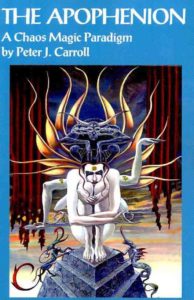
The Apophenion
A Chaos Magic Paradigm
Peter J. Carroll
ISBN: 978-1869928650
Format: Softcover
£15.00 / US$24
Subjects: Chaos Magic
Click HERE for The Apophenion / USA
Click HERE The Apophenion / UK
Click here for Kindle UK Edition
Click here for Kindle USA Edition
From the Author
“My final Magnum Opus if its ideas remain unfalsified within my lifetime, otherwise its back to the drawing board.
Yet I’ve tried to keep it as short and simple as possible, it consists of eight fairly brief and terse chapters and five appendices. It attacks most of the great questions of being, free will, consciousness, meaning, the nature of mind, and humanity’s place in the cosmos, from a magical perspective.
Some of the conclusions seem to challenge many of the deeply held assumptions that our culture has taught us, so brace yourself for the paradigm crash and look for the jewels revealed in the wreckage.This book contains something to offend everyone; enough science to upset the magicians, enough magic to upset the scientists, and enough blasphemy to upset most trancendentalists.”
The Apophenion cover artwork by David Gough www.davidgoughart.com
”Apophenia is the experience of seeing meaningful patterns or connections in random or meaningless data. The term was coined in 1958 by Klaus Conrad,[1] who defined it as the “unmotivated seeing of connections” accompanied by a “specific experience of an abnormal meaningfulness”. Source Wikipedia
Praise for Peter J. Carroll’s works
“The most original, and probably the most important, writer on Magick since Aleister Crowley.” Robert Anton Wilson, author of the Cosmic Trigger trilogy.
“Magicians feared they had lost Him to the world of Theoretical Physics, but Zarathustra has come down from the mountain. The Apophenion is spoken – and proves the wait was worth it. Religion starts the hunt for Meaning, and with science Meaning is killed and served up as Truth. So we need magic, sowing the seeds of Meaning in everyday events, and we need art to cultivate them to public awareness. Thus does Apopheniareveal how to bring back meaning to our diminished lives.” Lionel Snell, Aka Ramsey Dukes, author of SSOTBME.
REVIEWS
THE APOPHENION
by Peter J. Carroll
‘Framed as the outpouring of insight generated by the novel Goddess ‘Apophenia’, Pete Carroll’s new work is a real gem. Coming from a science background, this is his attempt to create a falisfiable model of why the universe looks the way it does, and just why magick can operate successfully.
In the inimitable Carrollian style we have come to know and love, our author sets out to demolish the edifices of being, consciousness, causality, the big-bang and more. In toppling these ontological Titans Pete discovers a universe of panpsychism and intense meaning.
If nothing else this agrees with my own views and is therefore a Good Thing. Pursuing this process through the scientific style of exploration means that quantum physics, special relativity et al show up pretty frequently in the text. If you buy this book expecting lists of planetary correspondence and ritual-by-numbers instructions you’re going to be disappointed.
However this doesn’t mean that this is all physics and no esoterica. Rather the point is that the reading of the universe that the author presents is suffused with magick. (Nevertheless there are some reassuring illustrations of occult entities and one explicit ritual – a rather lovely evocation of the Goddess Apophenia herself).
My reaction in reading this book was one of excitement. The suggestions that Pete advances tickle the mind delightfully. Certainly this isn’t Liber Null. It’s not a manual of techniques but instead concentrates on theory, yet that doesn’t make for a dull read. The theorisation presented here can light the touch paper of a hundred disciplines: cosmology and magick for sure but also Fortean studies, ethnography and especially neuro-biology.
Algebra explodes across the appendices of the book scattering the non-mathematicians towards the Epilogue where things are nicely rounded off in laypersons terms. The truth may well be that we live in vorticitating hypersphere with three dimensional time that, as the author beautifully asserts, “…invites us to become apprentice gods.” The very fact that I can now say ‘vorticitating hypersphere’ and know what that means is a testament to the authors explicatory powers.
The final and perhaps most wonderful thing about The Apophenion is how it demonstrates the development and maturation of Pete Carroll’s earlier writing. If nothing else this stands as a testament to the work of an individual (or perhaps conspiracy of selves!) who’s magick really does seem to work.
Eight chaospheres out of a possible eight!’
– Julian Vayne
